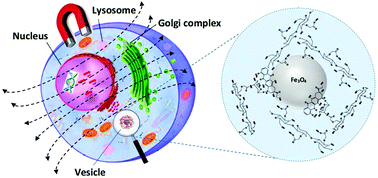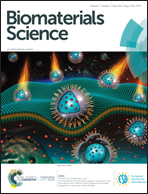Bifunctional magnetopolymersomes of iron oxide nanoparticles and carboxymethylcellulose conjugated with doxorubicin for hyperthermo-chemotherapy of brain cancer cells†
Abstract
Glioblastoma is the most aggressive primary brain cancer, which has no cure yet. Emerging nanotheranostic alternatives such as magnetic iron oxide nanoparticles (MIONs) have great potential as multimodal cancer therapy mediators. They can act as nanocarriers of anticancer drugs and generate localized heat when exposed to an alternating magnetic field (AMF), resulting in combined effects of chemotherapy and magnetic hyperthermia therapy. Thus, we designed and synthesized novel MIONs directly through a co-precipitation method by a single step one-pot aqueous green process using carboxymethylcellulose (CMC) as a multifunctional, biocompatible and water-soluble biopolymer ligand (iron oxide nanoparticle–CMC, MION@CMC). They were bioconjugated via amide bonds with doxorubicin (DOX, an anticancer drug) forming nanohybrids (MION@CMC–DOX). The CMC, MION@CMC and MION@CMC–DOX nanoconjugates were comprehensively characterized by 1HNMR, FTIR, TEM/SAED/EDX, UV-visible, XRD, zeta potential (ZP) and DLS analyses. Moreover, cytotoxicity and cell killing activities of these nanoconjugates were assessed by in vitro biological assays. The nanoconjugates were incubated with glioma cells (U87), a magnetic hyperthermia (MHT) assay was performed for evaluating the activity against brain cancer cells and confocal laser scanning laser microscopy was used for bioimaging their cellular uptake pathways. The results showed that fairly monodisperse and water-soluble ultra-small iron oxide nanoparticles (Fe3O4) were synthesized (core size = 7 ± 2 nm) and stabilized by CMC producing negatively charged nanocolloids (−38 ± 3 mV, MION@CMC; hydrodynamic radius, HD = 38 ± 2 nm). The results confirmed the conjugation of MION@CMC with DOX by amide bonds, leading to the development of magnetopolymersome nanostructures (MION@CMC–DOX). The cell viability bioassays evidenced low toxicity of MION@CMC compared to the severe cytotoxicity of MION@CMC–DOX nanosystems mainly caused by the release of DOX. Under an alternating magnetic field, MION@CMC and MION@CMC–DOX systems demonstrated activity for killing U87 cancer cells due to the heat generated by hyperthermia. In addition, the MION@CMC–DOX bioconjugates showed significantly higher cell killing response when exposed to an AMF due to the combined chemotherapy effect of DOX release inside the cancer cells triggering apoptotic pathways.



 Please wait while we load your content...
Please wait while we load your content...